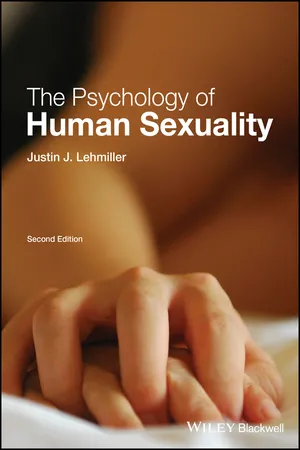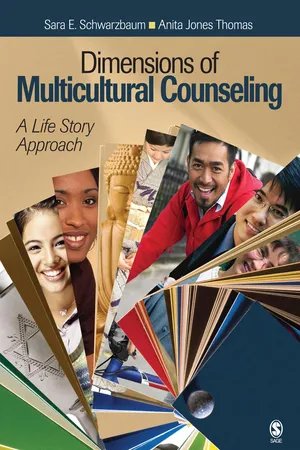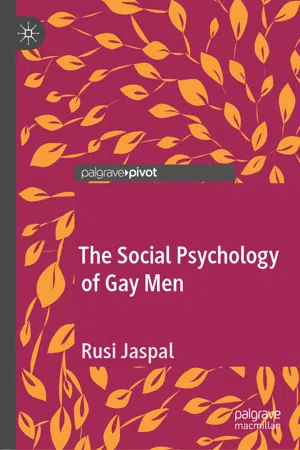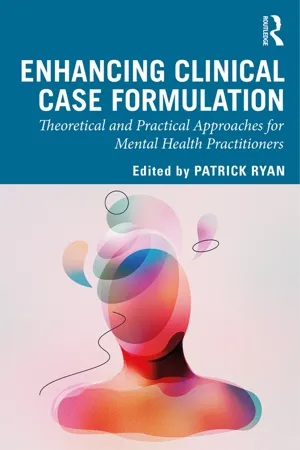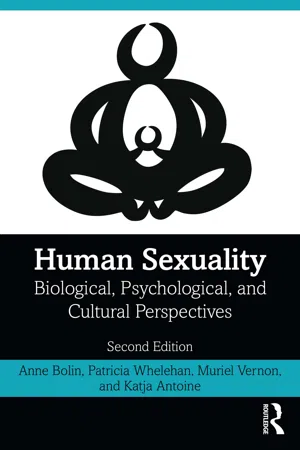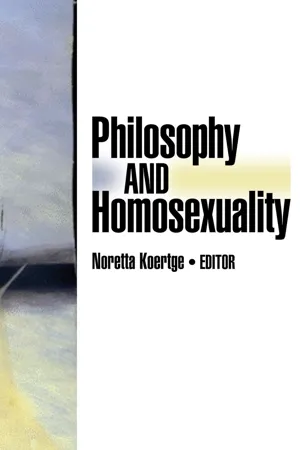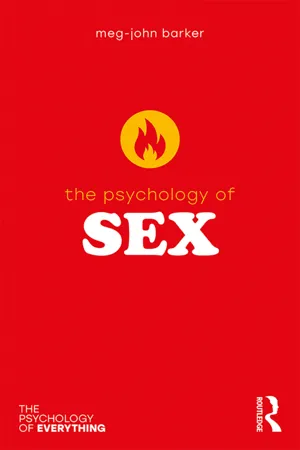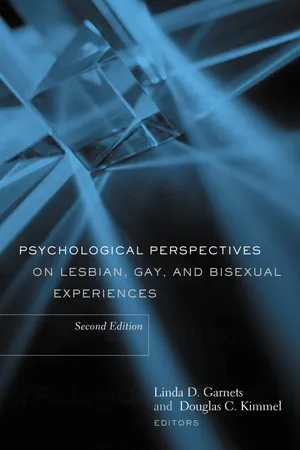Psychology
Sexual Orientation
Sexual orientation refers to an individual's enduring pattern of romantic or sexual attraction to others. It is often categorized as heterosexual, homosexual, or bisexual, but can also encompass other orientations. Sexual orientation is a fundamental aspect of a person's identity and can influence their relationships, self-concept, and overall well-being.
Written by Perlego with AI-assistance
Related key terms
11 Key excerpts on "Sexual Orientation"
- eBook - ePub
- Justin J. Lehmiller(Author)
- 2017(Publication Date)
- Wiley-Blackwell(Publisher)
Before we do that, however, it is important to acknowledge that there is no universally agreed-upon definition of this concept. Some people view Sexual Orientation as a matter of sexual attraction (i.e., who do you find sexually desirable?). Others view it as a matter of sexual behavior (i.e., who do you have sex with?). Yet others view it as a matter of psychological identity or labels (i.e., do you identify as gay, straight, bisexual, or something else?). Scientists adopt different definitions to suit their research purposes. For example, researchers in medicine and public health often focus on behavior and tend not to concern themselves with matters of identity because they want to understand infection risk. In contrast, researchers in psychology tend to focus more on attraction and identity because they are more concerned with how sexuality is perceived and psychologically experienced. These variable definitions have the effect of making the literature on Sexual Orientation difficult to decipher at times. For instance, as you will see in the next section, the way you define “Sexual Orientation” significantly affects prevalence estimates (e.g., consider that far more people have engaged in same-sex behavior than identify as gay or bisexual). Thus, when talking about Sexual Orientation, it is important to look at it through a broad lens that takes into account attraction, behavior, and identity, and recognize that these factors may express themselves very differently in different individuals. For purposes of this textbook, we will therefore define Sexual Orientation as the unique pattern of sexual and romantic desire, behavior, and identity that each person expresses. Sexual Orientation can take many forms. Many people tend to think of it as comprising just three categories: heterosexual (interest in members of the other sex), homosexual (interest in members of the same sex), and bisexual (interest in men and women) - eBook - ePub
Dimensions of Multicultural Counseling
A Life Story Approach
- Sara E. Schwarzbaum, Anita Jones Thomas(Authors)
- 2008(Publication Date)
- SAGE Publications, Inc(Publisher)
Section VI
Dimensions of Sexual Orientation
S exual orientation is the romantic, sexual, or emotional attraction to another person. It is important to distinguish Sexual Orientation from other concepts with which it is often confused. Sexual Orientation is different from biological sex, which refers to the physical sexual characteristics with which people are born. Sexual Orientation is also different from gender identity, which is the psychological sense of being male or female. Finally, Sexual Orientation needs to be distinguished from the term gender, which can be defined as the socially constructed adherence to cultural norms for feminine and masculine behavior, thoughts, and feelings (Answers to your Questions, n.d.).Sexual Orientation cannot be viewed as a dichotomous variable since it exists along a continuum that ranges from exclusive homosexuality to exclusive heterosexuality and includes various forms of bisexuality (Answers to your Questions, n.d.; Elze, 2006; McClellan, 2006). The traditional polarization of Sexual Orientation into two discrete categories, homosexuality and heterosexuality, leaves out bisexuality and other Sexual Orientations (Division 44, 2000). An understanding of the differences among gender identity, gender expression, and Sexual Orientation is important. Sexual Orientation refers to one’s sexual attraction to men, women, or both, whereas gender identity refers to one’s sense of oneself as male, female, or transgender, and gender expression is the behavioral expression of either the gender identity or the Sexual Orientation (Answers to your Questions, n.d.).This section is divided into two subsections. The first subsection, Heterosexuality, Homosexuality, and Bisexual Gender Orientations, focuses on gay, lesbian, and biSexual Orientations and contains an introduction to these topics followed by the story of Karen, a woman who found out, after having been married for several years, that she was attracted to another woman. We read about her journey toward self-knowledge, self- expression, and self-acceptance. The second subsection, titled Transgender and Intersex Sexuality, focuses on transgender and intersex issues and contains an introduction to these topics, followed by a story written by the mother of a transgendered child, in which we read about the transformation of Ryan into Rachel. Each story has its own Content Themes and Clinical Applications sections, and each includes its own Toolbox Activity. - eBook - ePub
- Rusi Jaspal(Author)
- 2019(Publication Date)
- Palgrave Pivot(Publisher)
Part II Orientation or Identity?Passage contains an image
© The Author(s) 2019 R. Jaspal The Social Psychology of Gay Men https://doi.org/10.1007/978-3-030-27057-5_2Begin Abstract2. The Origins of Sexual Orientation
Abstract
In this chapter, the concept of Sexual Orientation is defined and methods of operationalising and measuring it are discussed. Empirical research into the origins of Sexual Orientation is outlined, beginning with the psychosocial paradigm, consisting of psychoanalysis and social learning theories, and then the psychobiological paradigm, which includes the theories of hormonal influences on the brain and of genetic underpinnings of Sexual Orientation. In the final section of this chapter, the social psychological implications of these distinct, opposing paradigms are discussed with a particular focus on the social representations of homosexuality and gay men that they may generate.End AbstractKeywords
Sexual Orientation Social learning theory Psychoanalysis Genetics HormonesSexual Orientation: Its Definition and Operationalisation
Sexual Orientation can be conceptualised as a trait that predisposes an individual to experience sexual attraction to people of the same sex (gay ), to people of the opposite sex (heterosexual), or to people of both sexes (bisexual). Over the years, many Sexual Orientation categories and terms have been used to describe sexual attraction among men, such as homosexual , gay , bisexual, heterosexual, straight and others. Undoubtedly, many more will be created in order to capture the nuances of one’s perceived Sexual Orientation. Each of these categories and future ones can also be thought of as social representations , evoking distinct meanings, images and values (see Chapter 1 ). Whether these categories represent Sexual Orientation or sexual identity - eBook - ePub
Enhancing Clinical Case Formulation
Theoretical and Practical Approaches for Mental Health Practitioners
- Patrick Ryan, Patrick Ryan(Authors)
- 2019(Publication Date)
- Routledge(Publisher)
The last 50 years have witnessed an explosion of literature on sexuality, which has resulted in the development of sexuality theory. Despite this and the increased attention on sexuality in our culture, defining sexuality remains ambiguous. While sexual behaviour is as old as humankind, sexuality, as a concept, was not introduced into language until recent centuries. The term first appeared in the 1800s, specifically relating to sex as a reproductive function (Heath 1982). In 1889, the word was used by a physician to describe the surgical removal of a woman’s ovaries to refer to the human capacity for sexual feelings. Since then it has been used repeatedly, both in medical and other settings, and its meaning has becoming more and more complex. In the nineteenth century, the sciences of psychology and sexology began to emerge, which began to classify, describe and quantify human sexual behaviour. In 1994, Laumann, Gagnon and Michaels suggested a model that helped to understand human sexuality. This model described human sexual experience in terms of attraction, behaviour and identity, which may or may not be constant. This idea was framed by Ollis et al. (2001) in a model called the sexual trichotomy. This model postulates that identity (how we identify as male, female or transgender), Sexual Orientation (who we are attracted to) and sexual behaviour (or sexual acts) are fluid and have the capacity to change over time. This and other iterations of the concept have encouraged flexibility around thinking about sexuality as a more multi-dimensional concept than simply heterosexuality and homosexuality or indeed, gender.Sexual gender or identityIdentity refers to one’s sense of self, thus the term gender identity refers to one’s sense of self as male, female or transgender (APA 2011). Sex is assigned at birth and is determined primarily by physical attributes such as the internal and external anatomy of the newborn. Gender on the other hand, refers to socially constructed roles and behaviours that society considers appropriate for boys and girls. When one’s gender identity and biological sex are not matching, the individual may identify as transsexual or another transgender category (cf. Gainor 2000). An increasing body of research has documented an association between difficulties in managing sexual identity and orientation with mental health difficulties.Sexual OrientationSexual Orientation refers to the gender of those to whom one is romantically and sexually attracted. Categories of Sexual Orientation generally include attraction to members of the other gender (heterosexuals), attraction to members of one’s own gender (gay men or lesbians) and attraction to members of both genders (bisexuals). While these categories are still widely used, research has proposed that Sexual Orientation does not necessarily appear in such definite categories and instead perhaps it occurs on a continuum (e.g. Kinsey, Pomeroy, Martin and Gebhard 1953; Klein 1993). This open discussion and expression of gender identity and orientation in the media highlights society’s growing interest and openness to variance in how the sexual self is both experienced internally and expressed externally. While Sexual Orientation and identity is becoming less binary, a significant number of people still experience distress associated with their sexual identity and orientation, which in many cases can contribute to initiating or maintaining psychological distress. - Brian D. Earp, Clare Chambers, Lori Watson, Lori Watson, Clare Chambers, Brian D. Earp(Authors)
- 2022(Publication Date)
- Routledge(Publisher)
Collectively, the findings reviewed above underscore the importance of distinguishing between different types of sexual phenomenology experienced in different contexts when investigating Sexual Orientation. Although sexual desire, sexual attraction, sexual arousal, sexual fantasy, and sexual pleasure are related constructs, they are not interchangeable, and the factors driving variation in one dimension do not necessarily drive variation in the others. The types of stimuli to which one is drawn during solitary masturbation do not necessarily provide meaningful information about one’s preferred sexual partners, and the extent of correspondence among different aspects of sexual experience remains an open question. Such issues are obviously meaningful to scientists trying to measure and understand Sexual Orientation, but they are also meaningful on a broader conceptual level. Recognition of the obstacles that scientists have faced in operationalizing and measuring Sexual Orientation lays bare the underlying conceptual and theoretical bases on which these investigations have been premised. For this reason, delving into the problem of Sexual Orientation from a scientific and methodological point informs much deeper philosophical questions regarding how we understand and represent human experience and its manifestations in both mind and body, and the role of social and cultural context in shaping erotic experience.Problem #3: Change Over Time
Historically, Sexual Orientation has been considered an immutable or fixed trait, such that individuals were presumed to have the same basic pattern of same-gender and other-gender sexual attraction across the lifespan (I use the conventional term sexual attraction despite the inherent ambiguity of this term that I critiqued in the previous section). Yet a growing body of longitudinal evidence (reviewed in Diamond 2016 ) has shown that one’s specific distribution of same-gender and other-gender desires and behaviors may shift over time. Importantly, such emergent changes should not be confused with effortful attempts to extinguish same-gender attractions that some individuals seek through so-called reparative or conversion therapy, which is both ineffective and psychologically damaging (APA Task Force on Appropriate Therapeutic Responses to Sexual Orientation 2009 ).Several large-scale studies have asked individuals to describe their overall pattern of attractions (i.e., totally heterosexual, mostly heterosexual, bisexual) at different points in time, several years apart. These studies reliably find that a subset of individuals report changes in these patterns over time, for example switching from bisexual to exclusively gay/lesbian, or switching from mostly heterosexual to exclusively heterosexual (Mock and Eibach 2012 ; Ott et al. 2011 ; Savin-Williams et al. 2012 ). The question of why such changes occur remains unresolved (Diamond 2007 , 2012; Kuhle and Radke 2013 ; Ross et al. 2012 ; Yost and McCarthy 2012- eBook - ePub
Human Sexuality
Biological, Psychological, and Cultural Perspectives
- Anne Bolin, Patricia Whelehan, Muriel Vernon, Katja Antoine(Authors)
- 2021(Publication Date)
- Routledge(Publisher)
Although acknowledging and recognizing these explanations about Sexual Orientation, this chapter posits that human sexuality is part of what makes us human, that it is an interaction of biological and learned experiences whose boundaries are currently unknown to us. Our Sexual Orientation is part of our socio-psychological and biological makeup. Increasingly, we will probably learn that orientation itself has a biological component (Money, 1988; Small, 1993). Yet each society channels sexual behavior into culturally defined appropriate outlets. The following sections examine straight, gay, bi, and lesbian lifestyles as functions of their cultural milieus and as dimensions of the richness, adaptability, and diversity of the human sexual repertoire.Bisexuality
There is increasing research on bisexuality, but less than exists for gays and straights (Klein, 1978; Paul, 1984; Rust, 1999; Tielman, Carballo, and Hendriks, 1991). A biSexual Orientation is a romantic and sexual attraction toward both men and women. Both men and women can self-identify as bisexual. Bisexuals may choose only same-sex partners, partners of the other sex only, or of both sexes and genders. (Bisexuality is not synonymous with group sex where people have multiple partners concurrently.) The following statements come from one of your author’s files (Whelehan):I am a self-identified [male] bisexual who generally acts out on my attraction to men. However, every once in a there is a woman to whom I’m strongly emotionally and sexually attracted and I decide to pursue that interest.I believe everyone is pansexual [open to a variety of sexual experiences]. I am attracted to both men and women and don’t care about society’s labels. (Female) It’s natural. It’s an extension and expression of the love I feel for some of the people in my life, both men and women. (Female)Of all the Sexual Orientations discussed, bisexuality appears to receive the least acceptance, even though bisexual behavior has been estimated to be the highest. However, estimates of bisexuality are contradictory in current research. As of 2011, one study indicates that among adults who identify as lesbian, gay, or bisexual, there are slightly more bisexual-identifying people (1.8 percent) than lesbian or gay individuals (1.7 percent) (Gates, 2011: 3). The National Health Interview Survey performed by the CDC in 2013 indicated 96.6 percent of American adults identified as heterosexual, 1.6 percent identified as lesbian or gay, and 0.7 percent identified as bisexual. The remaining 1.1 percent said they identified as something else, didn’t know, or refused to answer (Ward et al., 2014: 5). - eBook - ePub
- Noretta Koertge(Author)
- 2014(Publication Date)
- Routledge(Publisher)
While declaring that homosexuality is multifaceted, investigators at the Institute for Sex Research (Bell & Weinberg, 1978; Kinsey, et al., 1948, 1953; Weinberg & Williams, 1974) have assessed Sexual Orientation as a unitary phenomenon, as physical behavior and feeling. The original Kinsey group (1948, 1953) recognized that psychic reactions (i.e., physical attraction to desired partners) as well as physical contact and orgasms had to be considered in classifying individuals on the heterosexual-homosexual scale, even though they observed that most of their respondents received parallel ratings. Bell and Weinberg (1978, p. 35) used two Kinsey scales, one for assessing physical contact, the other for sexual feelings, and developed a summary measure of 0 to 12. A respondent was assigned to the homosexual group if her or his score was 4 or more. After identifying the homosexual respondents, however, the authors did not then investigate how the ratings might be related to the variations found in sexual, social, and psychological adjustment.In order for research on Sexual Orientation to advance during the 1980s, it will be necessary to study the relationships among emotions, fantasies, and the physical aspects of sex, and to explore how societies and cultures determine which aspects of sexuality are to be suppressed, suffered, or enjoyed. To identify and combine the major strands of experience that comprise Sexual Orientation, investigators at the Center for Homosexual Education, Evaluation and Research (C.H.E.E.R.) have conceptualized Sexual Orientation as a distinct component of sexual identity, embracing physical, interpersonal, and intrapsychic factors (Shively & De Cecco, 1977). In this conceptualization there are four components: (1) biological sex, (2) gender identity, (3) social sex-role, and (4) Sexual Orientation. Biological sex designates the sex of the neonate as female or male, a determination usually made by the obstetrician upon delivery of the infant. In most instances the chromosomal sex and the morphological sex are congruent. When they are not, doctors have been known to be mistaken, as in the case of hermaphrodites. Gender identity refers to the individual's basic conviction of being female or male. This conviction is not necessarily contingent upon the individual's biological sex. In the case of post-operative transsexuals, gender identity is congruent with morphological but not with chromosomal sex. Gender identity is usually present by the time the child begins to talk. Social sex-role identifies the physical and psychological characteristics that are culturally associated with females or males. Social sex-role stereotypes are cultural expectations of appropriate physical and psychological characteristics of females and males. These characteristics are perceived as feminine or masculine. Six aspects of social sex-roles have been identified (Shively, Rudolph, & De Cecco, 1978): physical appearance, personality, mannerisms, speech, interests, and habits. Sexual Orientation refers to the individual's physical sexual activity with, interpersonal affection for, and erotic fantasies about members of the same or opposite biological sex. Physical sexual activity designates the individual's erotic body contact with one or more persons; this may or may not include genital contact. Interpersonal affection refers to associations, involving varying degrees of love or trust, with coworkers, friends, lovers, and marital partners. These relationships do not necessarily include or exclude physical sexual activity. Erotic fantasies - eBook - ePub
- Meg John Barker(Author)
- 2018(Publication Date)
- Routledge(Publisher)
2 Sex and Sexuality We tend to see sex as a fundamental aspect of who we are as human beings. A person’s sexuality is regarded as a vital aspect of their identity: a key piece of demographic information to measure alongside their gender, age, and ethnicity. We think it’s important for people to be open about their sexuality: to ‘come out’ about who they are. And our knowledge or assumptions about a person’s sexuality affects our expectations about what they’ll be like as a person. What is Sexuality? But what do we mean by sexuality? Think for a moment about what your answer would be if you were asked for your sexuality on a form or questionnaire. Before we get into this chapter let’s pull out some of the common cultural assumptions about sexuality. As we do so, you can start to think about whether or not they reflect your understanding and experience of sexuality. The terms ‘sexuality’, ‘sexual identity’, and ‘Sexual Orientation’ tend to be used fairly interchangeably, and the latter two terms help to unpack what we generally mean by sexuality. It’s a key feature of a person’s identity which is defined by who they orient towards sexually: in other words, who they are sexually attracted to. As an identity, sexuality is generally assumed to be an essential aspect of who we are: part of our fundamental essence as a human being. As such, it’s generally assumed to be fixed and unchanging over the course of a life, which is partly why it makes sense to ask it as a piece of demographic information. It’s often assumed to be a natural or biological feature of who we are: you were born this way and you’ll stay this way. As an orientation, sexuality is all about who we’re sexually attracted to in terms of our sex and theirs. Are we attracted to the ‘opposite sex’ or the ‘same sex’? Are we heterosexual or homosexual? There’s generally an assumption that people are heterosexual unless they say otherwise. Coming out is associated with gay rather than straight people - eBook - ePub
- Michael R. Kauth(Author)
- 2013(Publication Date)
- Routledge(Publisher)
behaviors of men are differentially related to Sexual Orientation, but only insomuch as the pool of potential mates for gay men consists of other men and their sociosexual attitudes, and is not impacted by the relatively restricted attitudes of women. The sexual psychology of women across cultures also shows a distinctive, recurring pattern. In general, heterosexual women and lesbians share many of the same features (e.g., restricted sociosexuality), whereas bisexual women across all cultures tend to be more unrestricted in terms of both attitudes and behaviors.Issues for Further Consideration
In the ISDP, Sexual Orientation was primarily measured with a simple categorical item in which participants circled one of three choices: heterosexual, homosexual, or bisexual. The use of simple self-identification for assessing Sexual Orientation is problematic (Gonsiorek & Weinrich, 1995; Haslam, 1997). In the current study, scores on self-identification categories did converge with the bipolar measure of Sexual Orientation from the Sexy Seven measure (Schmitt & Buss, 2000). Still, individual differences in Sexual Orientation cannot be fully measured by unidimensional characterizations or trichotomous constructs, although Sexual Orientation is most commonly measured in this way (Chung & Katayama, 1996). Moreover, same-sex Sexual Orientations are not the same as same-sex sexual behaviors (Muscarella, 1999), and gays and lesbians may define “sexual behavior” in different ways than do heterosexuals (Carpenter, 2001; Vohs, Catanese, & Baumeister, 2004), particularly across cultures. Indeed, self-labeling as a homosexual or bisexual carries with it extreme social costs in many non-Western cultures, something not fully accounted for in the current study. In the future, measurements of the full spectrum of Sexual Orientations and specific sexual behaviors are needed to more formally evaluate evolutionary perspectives on human mating. - eBook - ePub
Philosophy of Sex and Love
An Opinionated Introduction
- Patricia Marino(Author)
- 2019(Publication Date)
- Routledge(Publisher)
8 Orientations of sex and loveIntroduction
“Orientation” has become one of our society’s principal terms for discussing how people experience attraction and love. We commonly describe individuals in terms of their orientations, as “gay,” “lesbian,” “straight,” and “bisexual,” though, as we will see, these hardly scratch the surface of the many ways people experience attraction and orientation. Though orientations are often discussed as matters pertaining specifically to sex, orientations obviously relate also to love, romance, and family life. That’s why this chapter is called “Orientations of Sex and Love.”The term “LGBTQ” stands for “lesbian, gay, bisexual, trans, and queer and/or questioning”; other initials are sometimes added – for example, A for asexuality or I for intersex. For simplicity, I’ll use the abbreviation LGBTQ+. This chapter begins with an explication of this terminology. When we discuss why LGBTQ+ people should be afforded equal rights and respect, we often hear about the idea of “born that way” and “not a choice”: that because we are born with certain orientations, and thus cannot change them, orientations cannot be a justification for discrimination. Relatedly, there has been a lot of recent scientific research into orientations, with the implication that the science will be relevant to politics: if orientations are genetic and biological, the thinking goes, they are fixed and stable aspects of a person, aspects that must be treated with respect. But, as we’ll see in this chapter, the “born that way” and “not a choice” arguments have various conceptual and ethical complexities, and they are insufficient for grounding the relevant equal rights and freedoms. Furthermore, taking a scientific view of orientations can have surprising negative effects. What is needed, I’ll argue, is positive affirmation and valuing of the ways of life of LGBTQ+ people. - Linda Garnets, Douglas Kimmel(Authors)
- 2003(Publication Date)
- Columbia University Press(Publisher)
any homosexual attractions or behavior indicated a homoSexual Orientation, and individuals who claimed a bisexual identity were seen as psychologically and socially maladjusted just as lesbians and gay men were considered maladjusted from the point of view of the illness model.At the same time, the results of research on human sexuality clearly indicated that many individuals have experienced both heterosexual and homosexual attractions and behavior. Furthermore, research found no indication of psychopathology in nonclinical samples of bisexual women and men, just as prior research had found no evidence of psychopathology in nonclinical samples of lesbians and gay men.No single pattern of homosexual and heterosexual attractions, behavior, and relationships characterizes self-identified bisexual men and women. Individuals arrive at their sexual identities by various routes. For some women and men, sexual identity remains constant, whereas for others, sexual identity varies in response to changes in sexual and emotional attractions, behavior, and relationships and the social and political contexts in which these occur. Finally, one of the main differences between bisexual men and women and gay men and lesbians is in the degree to which a visible community of similar others exists and serves to support the individual in the coming-out process. The extensive support networks that have developed in many communities have served this purpose for lesbians and gay men. While bisexual men and women often have looked to gay and lesbian communities for support and understanding regarding their homosexual interests and sexual minority status, the bisexual groups and organizations now emerging may be able to support them more effectively in the process of coming out bisexual and in their efforts to affiliate with other bisexual women and men.
Index pages curate the most relevant extracts from our library of academic textbooks. They’ve been created using an in-house natural language model (NLM), each adding context and meaning to key research topics.
